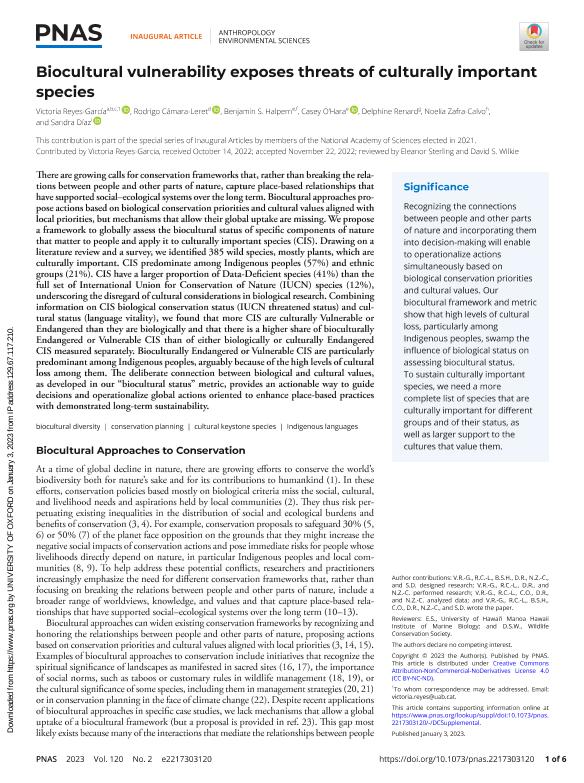Mostrar el registro sencillo del ítem
dc.contributor.author
Reyes García, Victoria
dc.contributor.author
Cámara Leret, Rodrigo
dc.contributor.author
Halpern, Benjamin S.
dc.contributor.author
O'Hara, Casey
dc.contributor.author
Renard, Delphine
dc.contributor.author
Zafra Calvo, Noelia
dc.contributor.author
Díaz, Sandra Myrna

dc.date.available
2024-01-18T17:33:15Z
dc.date.issued
2023-01
dc.identifier.citation
Reyes García, Victoria; Cámara Leret, Rodrigo; Halpern, Benjamin S.; O'Hara, Casey; Renard, Delphine; et al.; Biocultural vulnerability exposes threats of culturally important species; National Academy of Sciences; Proceedings of the National Academy of Sciences of The United States of America; 120; 2; 1-2023; 1-6
dc.identifier.issn
0027-8424
dc.identifier.uri
http://hdl.handle.net/11336/224177
dc.description.abstract
There are growing calls for conservation frameworks that, rather than breaking the relations between people and other parts of nature, capture place-based relationships that have supported social–ecological systems over the long term. Biocultural approaches propose actions based on biological conservation priorities and cultural values aligned with local priorities, but mechanisms that allow their global uptake are missing. We propose a framework to globally assess the biocultural status of specific components of nature that matter to people and apply it to culturally important species (CIS). Drawing on a literature review and a survey, we identified 385 wild species, mostly plants, which are culturally important. CIS predominate among Indigenous peoples (57%) and ethnic groups (21%). CIS have a larger proportion of Data-Deficient species (41%) than the full set of International Union for Conservation of Nature (IUCN) species (12%), underscoring the disregard of cultural considerations in biological research. Combining information on CIS biological conservation status (IUCN threatened status) and cultural status (language vitality), we found that more CIS are culturally Vulnerable or Endangered than they are biologically and that there is a higher share of bioculturally Endangered or Vulnerable CIS than of either biologically or culturally Endangered CIS measured separately. Bioculturally Endangered or Vulnerable CIS are particularly predominant among Indigenous peoples, arguably because of the high levels of cultural loss among them. The deliberate connection between biological and cultural values, as developed in our “biocultural status” metric, provides an actionable way to guide decisions and operationalize global actions oriented to enhance place-based practices with demonstrated long-term sustainability.
dc.format
application/pdf
dc.language.iso
eng
dc.publisher
National Academy of Sciences

dc.rights
info:eu-repo/semantics/openAccess
dc.rights.uri
https://creativecommons.org/licenses/by-nc-sa/2.5/ar/
dc.subject
BIOCULTURAL DIVERSITY
dc.subject
CONSERVATION PLANNING
dc.subject
CULTURAL KEYSTONE SPECIES
dc.subject
INDIGENOUS LANGUAGES
dc.subject.classification
Otras Ciencias de la Tierra y relacionadas con el Medio Ambiente

dc.subject.classification
Ciencias de la Tierra y relacionadas con el Medio Ambiente

dc.subject.classification
CIENCIAS NATURALES Y EXACTAS

dc.title
Biocultural vulnerability exposes threats of culturally important species
dc.type
info:eu-repo/semantics/article
dc.type
info:ar-repo/semantics/artículo
dc.type
info:eu-repo/semantics/publishedVersion
dc.date.updated
2024-01-16T14:00:21Z
dc.identifier.eissn
1091-6490
dc.journal.volume
120
dc.journal.number
2
dc.journal.pagination
1-6
dc.journal.pais
Estados Unidos

dc.journal.ciudad
Washington DC
dc.description.fil
Fil: Reyes García, Victoria. Institució Catalana de Recerca I Estudis Avançats; España. Universitat Autònoma de Barcelona. Departament d’Antropologia Social i Cultural; España. Universitat Autònoma de Barcelona. Institut de Ciència i Tecnologia Ambientals; España
dc.description.fil
Fil: Cámara Leret, Rodrigo. Universitat Zurich; Suiza
dc.description.fil
Fil: Halpern, Benjamin S.. University of California. Bren School of Environmental Science and Management; Estados Unidos. University of California. National Center for Ecological Analysis and Synthesis; Estados Unidos
dc.description.fil
Fil: O'Hara, Casey. University of California. Bren School of Environmental Science and Management; Estados Unidos
dc.description.fil
Fil: Renard, Delphine. Université Montpellier II; Francia
dc.description.fil
Fil: Zafra Calvo, Noelia. Basque Centre for Climate Change. Scientific Campus of the University of the Basque Country; España
dc.description.fil
Fil: Díaz, Sandra Myrna. Universidad Nacional de Córdoba. Facultad de Ciencias Exactas, Físicas y Naturales; Argentina. Consejo Nacional de Investigaciones Científicas y Técnicas. Centro Científico Tecnológico Conicet - Córdoba. Instituto Multidisciplinario de Biología Vegetal. Universidad Nacional de Córdoba. Facultad de Ciencias Exactas Físicas y Naturales. Instituto Multidisciplinario de Biología Vegetal; Argentina
dc.journal.title
Proceedings of the National Academy of Sciences of The United States of America

dc.relation.alternativeid
info:eu-repo/semantics/altIdentifier/doi/http://dx.doi.org/10.1073/pnas.2217303120
dc.relation.alternativeid
info:eu-repo/semantics/altIdentifier/url/https://www.pnas.org/doi/10.1073/pnas.2217303120
Archivos asociados
